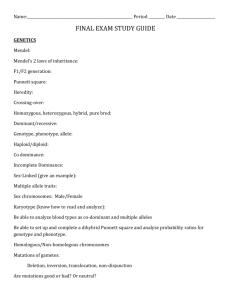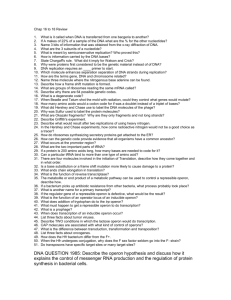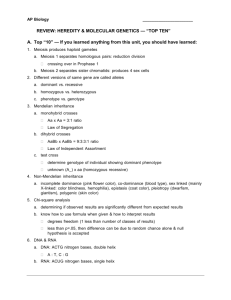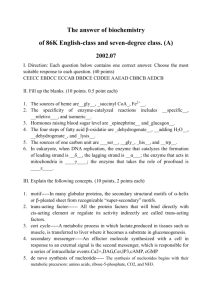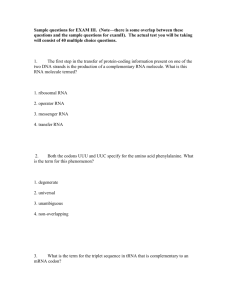Exam 3
advertisement
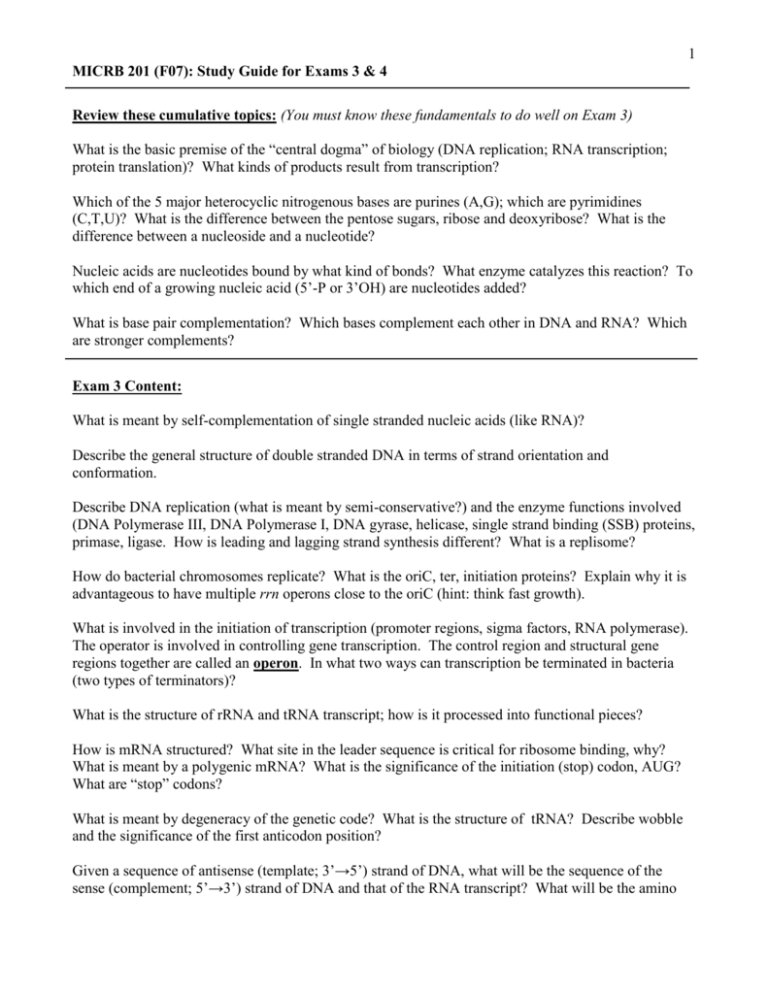
1 MICRB 201 (F07): Study Guide for Exams 3 & 4 Review these cumulative topics: (You must know these fundamentals to do well on Exam 3) What is the basic premise of the “central dogma” of biology (DNA replication; RNA transcription; protein translation)? What kinds of products result from transcription? Which of the 5 major heterocyclic nitrogenous bases are purines (A,G); which are pyrimidines (C,T,U)? What is the difference between the pentose sugars, ribose and deoxyribose? What is the difference between a nucleoside and a nucleotide? Nucleic acids are nucleotides bound by what kind of bonds? What enzyme catalyzes this reaction? To which end of a growing nucleic acid (5’-P or 3’OH) are nucleotides added? What is base pair complementation? Which bases complement each other in DNA and RNA? Which are stronger complements? Exam 3 Content: What is meant by self-complementation of single stranded nucleic acids (like RNA)? Describe the general structure of double stranded DNA in terms of strand orientation and conformation. Describe DNA replication (what is meant by semi-conservative?) and the enzyme functions involved (DNA Polymerase III, DNA Polymerase I, DNA gyrase, helicase, single strand binding (SSB) proteins, primase, ligase. How is leading and lagging strand synthesis different? What is a replisome? How do bacterial chromosomes replicate? What is the oriC, ter, initiation proteins? Explain why it is advantageous to have multiple rrn operons close to the oriC (hint: think fast growth). What is involved in the initiation of transcription (promoter regions, sigma factors, RNA polymerase). The operator is involved in controlling gene transcription. The control region and structural gene regions together are called an operon. In what two ways can transcription be terminated in bacteria (two types of terminators)? What is the structure of rRNA and tRNA transcript; how is it processed into functional pieces? How is mRNA structured? What site in the leader sequence is critical for ribosome binding, why? What is meant by a polygenic mRNA? What is the significance of the initiation (stop) codon, AUG? What are “stop” codons? What is meant by degeneracy of the genetic code? What is the structure of tRNA? Describe wobble and the significance of the first anticodon position? Given a sequence of antisense (template; 3’→5’) strand of DNA, what will be the sequence of the sense (complement; 5’→3’) strand of DNA and that of the RNA transcript? What will be the amino 2 acid sequence of the polypeptide synthesized by the ribosome for this transcript (you will be given the genetic code table)? Describe the major steps in translation initiation (which ribosome subunit binds where on the mRNA and then what happens?) . Generally, what are initiation factors? Describe the major steps in translation termination. Generally, what are release factors? Know operon structure and role of operator in repression of gene expression (negative transcriptional regulation). How does induction and repression differ if they both involve a repressor protein? How is the lactose (lac) operon a good example of an inducible operon? Positive transcriptional regulation of the lac operon involves bindings of the CAP to the promoter. Under what conditions can this happen and what is the outcome with allolactose or without allolactose? How does lac operon regulation explain diauxic growth of Escherichia coli grown on media with both glucose and lactose? In an operon regulated by attenuation, what is unique about the leader sequence of its mRNA transcript? How do these regions control the fate of transcription? Understand the tryptophan operon attenuation. Why does structural gene transcription proceed in the absence of trp (and trp-tRNA)? What is meant by recombination of DNAs? What is the difference between reciprocal homologous recombination versus non-reciprocal homologous recombination? Explain the basic principle of natural transformation that occurs in some taxa of bacteria. How did Griffith demonstrate this experimentally? What utility is artificial transformation in biotechnology? Describe the structure and function of plasmid types. By what two ways may a plasmid replicate. Describe the rolling circle mechanism of replication. How does a virus use rolling circle replication ot make multiple copies of its genome? Be able to explain the difference between F- , F+, Hfr, and F’ cells and how they originate. What happens in the following mating scenarios and explain their outcome: F+ x FHrf x FF’ x FWhat does it mean that viruses are obligate intracellular parasites? Appreciate their relative size scale to other typical bacteria and eukaryote cells. What are the main components of a viral particle, i.e. a virion? What kinds of nucleic acids? What shapes of capsids are made from capsomere proteins. What other protein structures may be involved in specific attachment to host cells and viral nucleic acid transfer. What is an enveloped virus? What is the source of the lipid membrane; how so? What about spike proteins (where from, what role)? How can you culture bacteriophage? How about eukaryote viruses? Why might a nurse ask you about having an egg allergy before administering a vaccine for the influenza virus. 3 Know the anatomy and function of a “T–even” bacteriophage. Know the lytic cycle, so to be able to match the five major steps with a description of each. Again, know rolling circle replication of viral genomes. Understand that a bacterial cell with a virus engaged in the lytic cycle will soon die. What is the lysogenic cycle, and specifically what is the prophage? Understand that not all bacteriophage are able to perform a lysogenic cycle, but all bacteriophage can perform a lytic cycle. Understand that a bacterium with a virus engaged in the lysigenic cycle will continue to live and multiply; thereby amplifying the number of prophage in a bacterial population. Know why a stressed bacterial cell with prophage, will induce the phage to the lytic cycle and kill the bacterium. How does this control operate at the molecular level, specifically what is the role of clrepressor, cro-activator, integrase and excisionase, and RecA*. BONUS: What is specialized transduction; how can it transfer a particular bacterial gene at a much greater probability than general transduction, which we discussed before? Appreciate the difference in nucleic acid types that store eukaryotic viral genomes. How is the host cell location (nucleus vs cytoplasm) for viral genome replication, protein synthesis and virion assembly differ for DNA versus ssRNA (+ or -) eukaryotic viruses? Know the role of RNA-dependent RNA polymerase in single stranded RNA viruses. Know what is a retrovirus, and the role of Reverse Transcriptase. Know different types of persistent infections and cell damage done by eukaryotic viruses.


